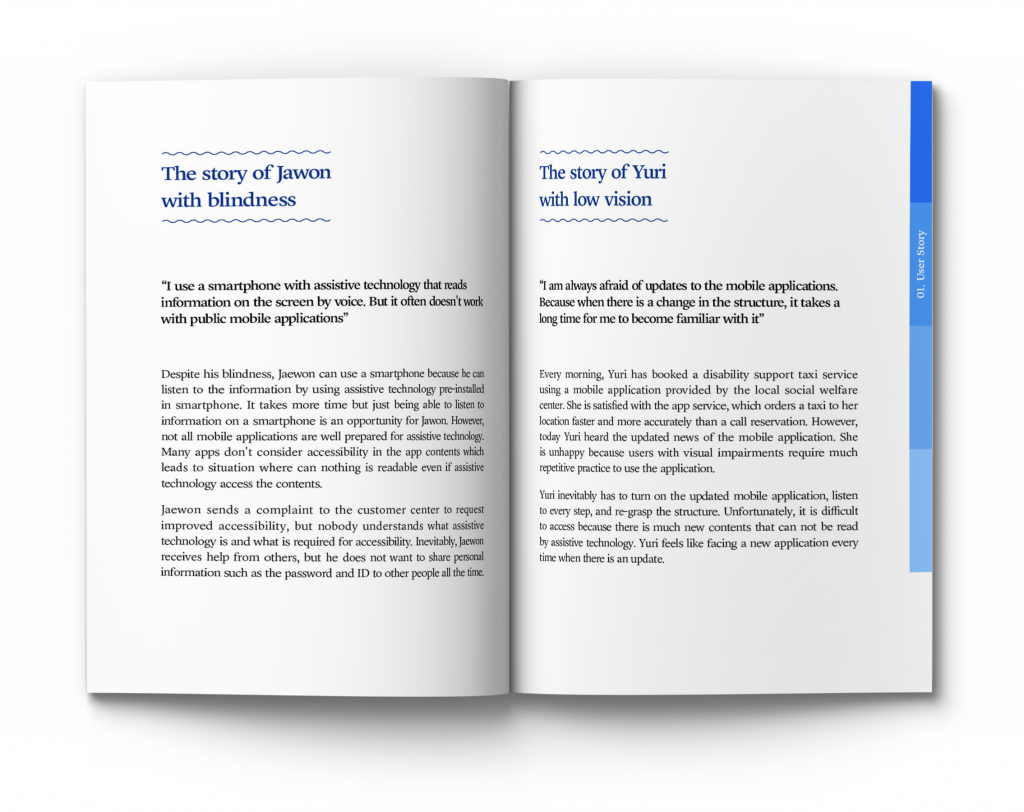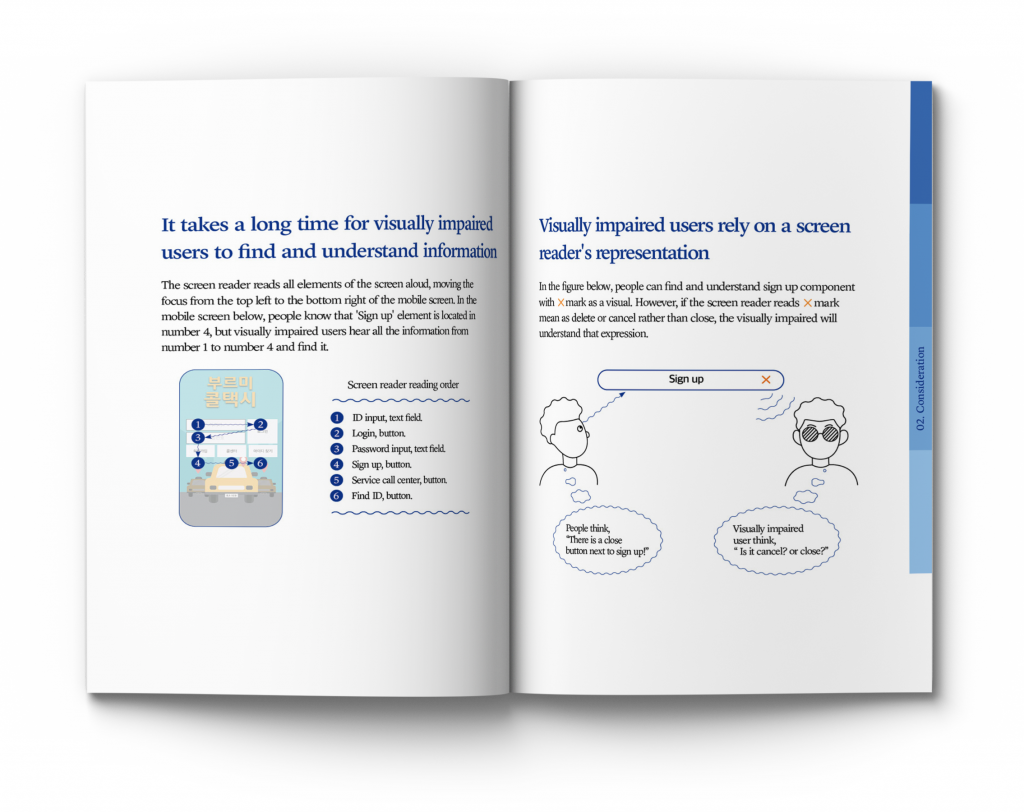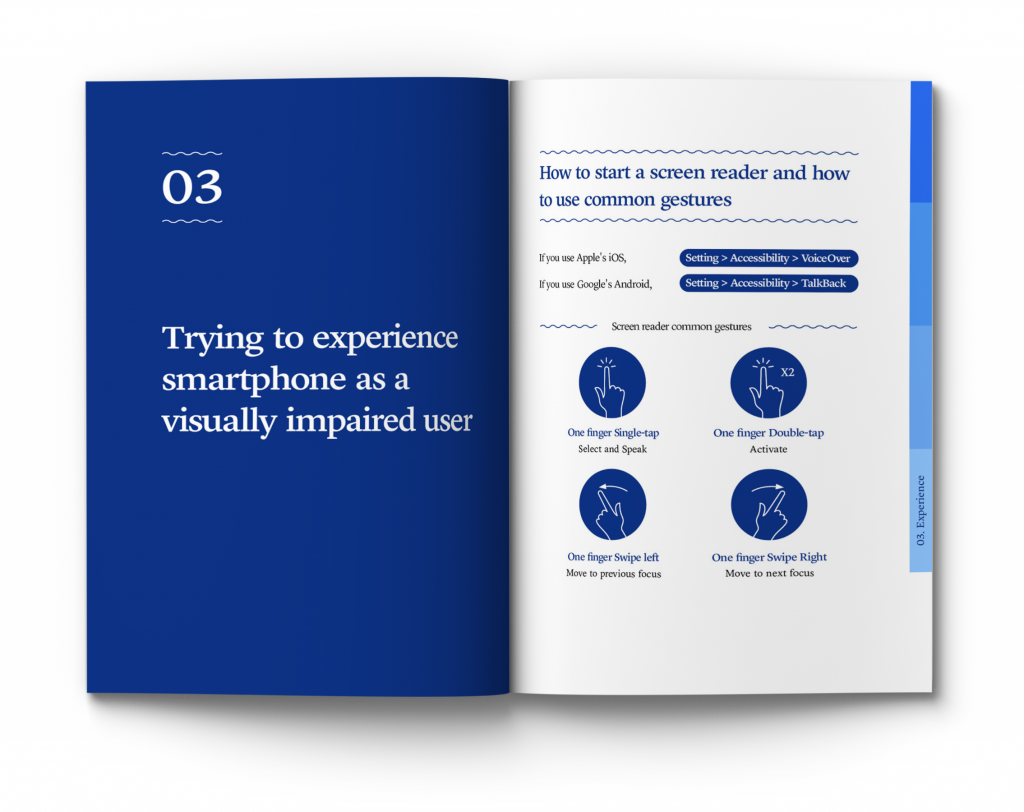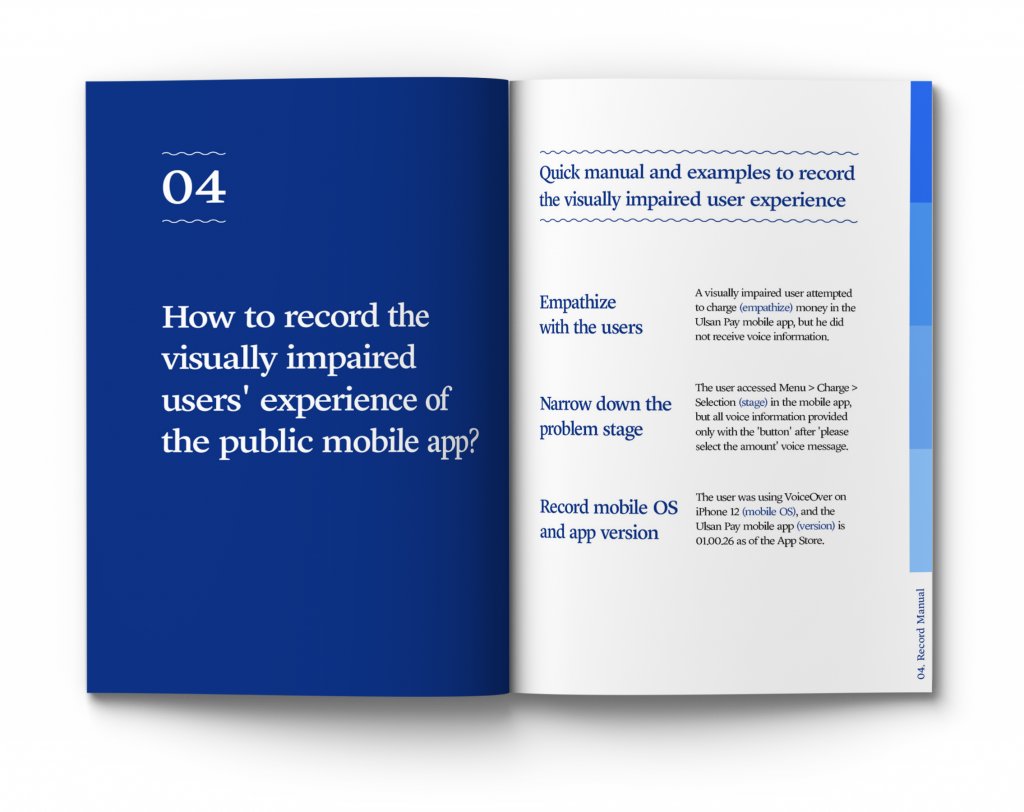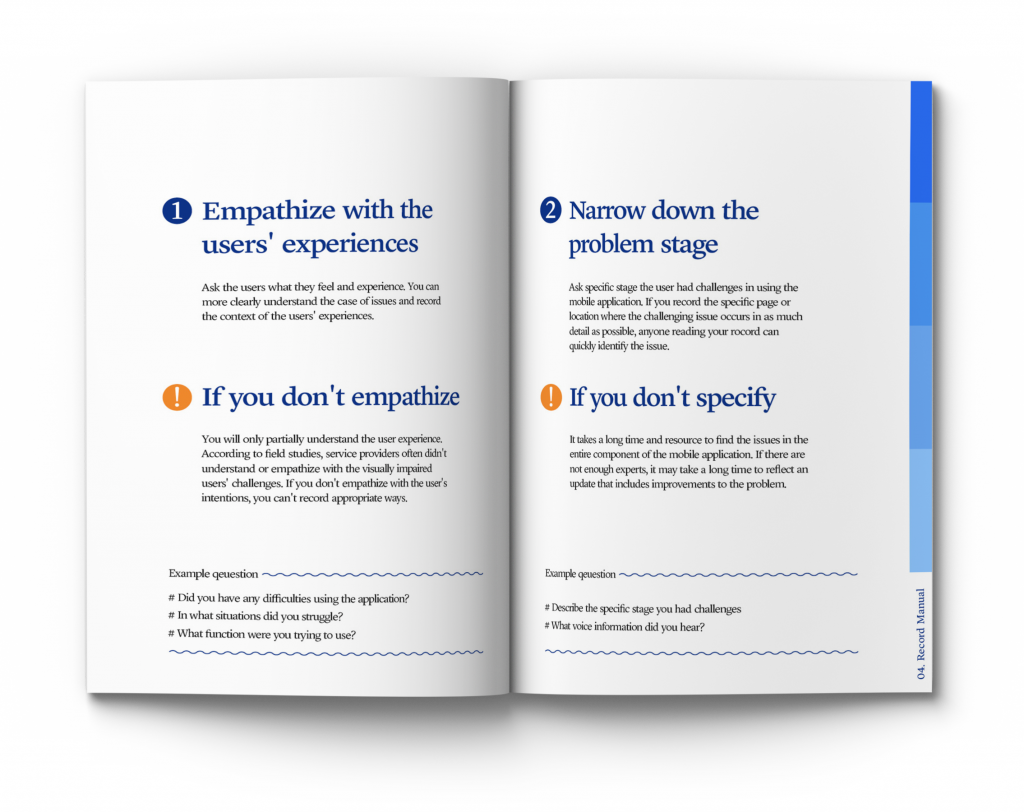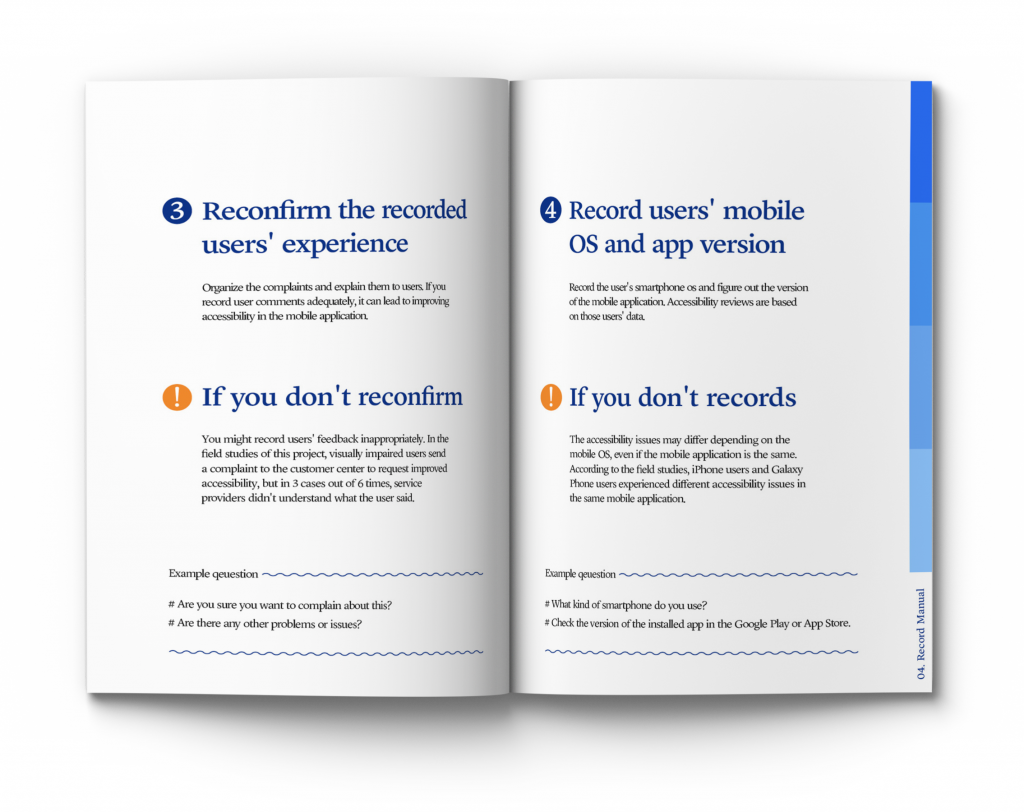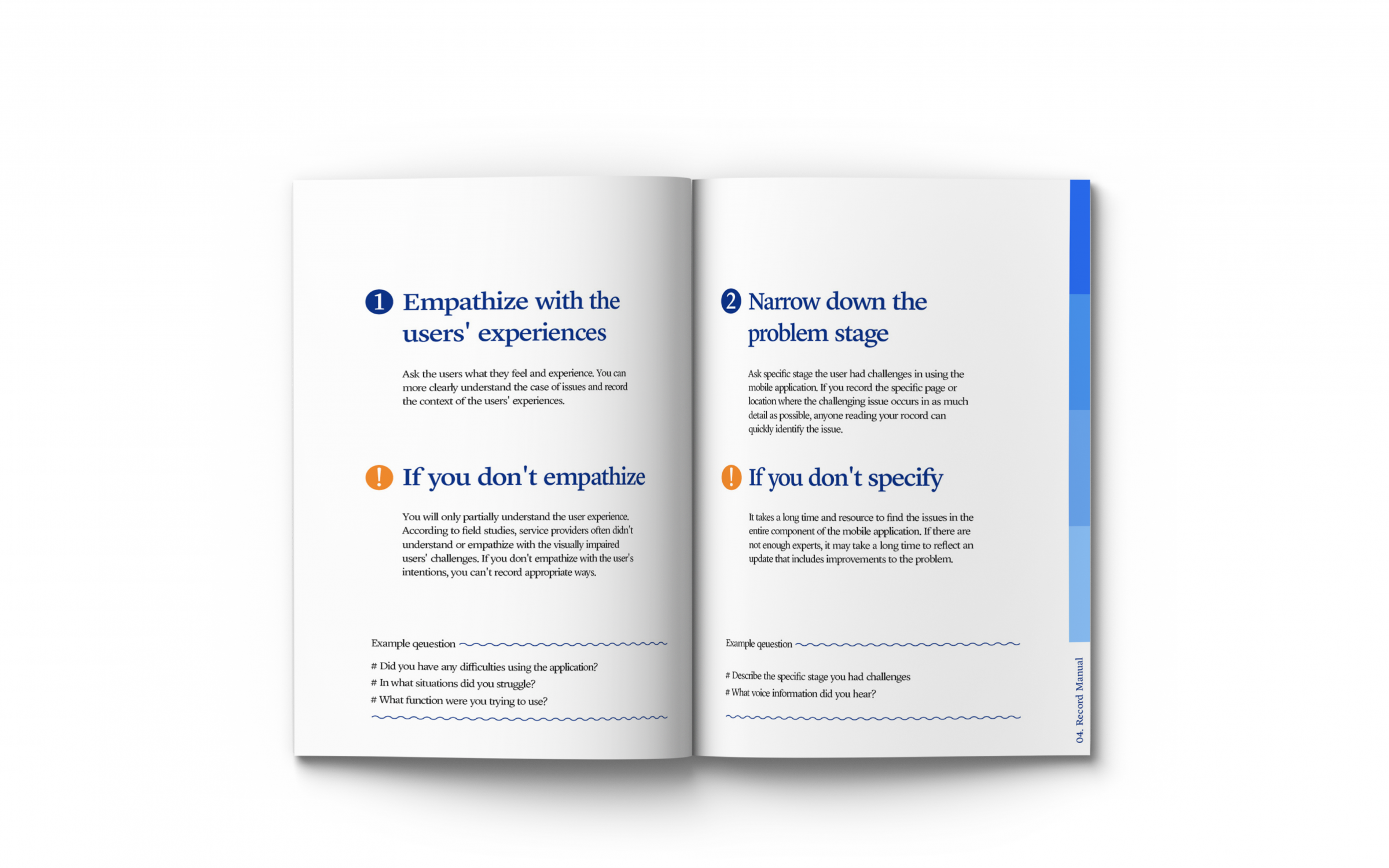
Master's Thesis
Beyond Mere Listening: A User Experience Record Manual to Improve Accessibility of Public Mobile Applications for the Visually Impaired
듣는 것, 그 이상을 위하여: 시각장애인의 공공 모바일 어플리케이션 접근성 개선을 위한 사용자 경험 기록 메뉴얼
This project aim to help build user experience record manual through which more equitable public digital services can be designed with improved accessibility so that anyone, including the visually impaired, can use them without any trouble.
The project embodied the accessibility issues arising from public welfare mobile application called ‘Bur-mi’ provided by municipalities from the perspective of users and service providers. In doing so, the aim is to get to know the real-life context of users and developers total of 16 people – public servants, designers, and programmers alike – and gain inspiration to explore a possible solution. People with visual impairments faced various accessibility issues from the increase of public mobile services, and they were expecting various accessibility improvements depending on the situation. In addition, I also discovered practical difficulties and limitations for service providers that were not known through quantitative research. These various insights will serve as a starting point for service providers to improve accessibility in the mobile service development process.
본 프로젝트는 시각장애를 가진 사용자를 포함하여 누구나 공공에서 제공하는 모바일 어플리케이션을 편리하게 사용할 수 있도록 향성된 접근성 시스템을 구축하는 것을 목표로 합니다. 시각 장애인 사용자가 서비스를 경험하며 겪는 다양한 이슈를 파악하고 디자이너의 관점에서 접근성 개선에 도움이 될 수 있는 방향성을 제안합니다.
이 프로젝트는 공공에서 제공하는 장애인 이동수단 예약 어플리케이션 ‘부르미’에서 발생하는 접근성 문제를 사용자와 서비스 제공자의 관점으로부터 관찰하며 시작되었습니다. 이 과정에서 실제 사용자와 서비스 개발자의 경험을 파악하기 위해 사용자, 공무원, 디자이너, 개발자 등 총 16명을 대상으로 정성적인 리서치를 진행하였습니다. 이를 통해, 시각장애인 사용자는 공공 디지털 서비스가 증가함에 따라 다양한 접근성 문제에 직면하고 있으며, 상황에 따라 다방면의 디지털 접근성 개선을 기대하고 있음을 알게되었습니다. 또한 정량적 연구를 통해 알려지지 않은 서비스 제공자에 대한 실질적인 어려움과 한계를 발견했습니다. 이러한 다양한 통찰의 발견은 공공 모바일 서비스 개발 과정에서 접근성을 향상시키는 해결방안을 찾는 출발점이 됩니다.
E-government Accessibility as a welfare issue
As of 2020, the Korean government operates and manages around 780 public mobile applications, each of which is produced to serve the needs of municipalities or government institutions.
However, a large number of citizens experience difficulties when using such digital services since many of these services are developed without complying with accessibility principles.
전자정부의 접근성은 복지의 문제이다
2020년 기준으로 한국 정부는 약 780개의 공공 모바일 어플리케이션을 운영 및 관리하고 있으며, 각각의 어플리케이션은 지자체 또는 정부기관의 요구로부터 만들어졌습니다.
그러나 이러한 디지털 서비스의 대부분은 적합한 접근성 원칙을 준수하지 않고 개발되기 때문에 많은 시민들이 디지털 서비스를 사용하는 데 어려움을 겪습니다.

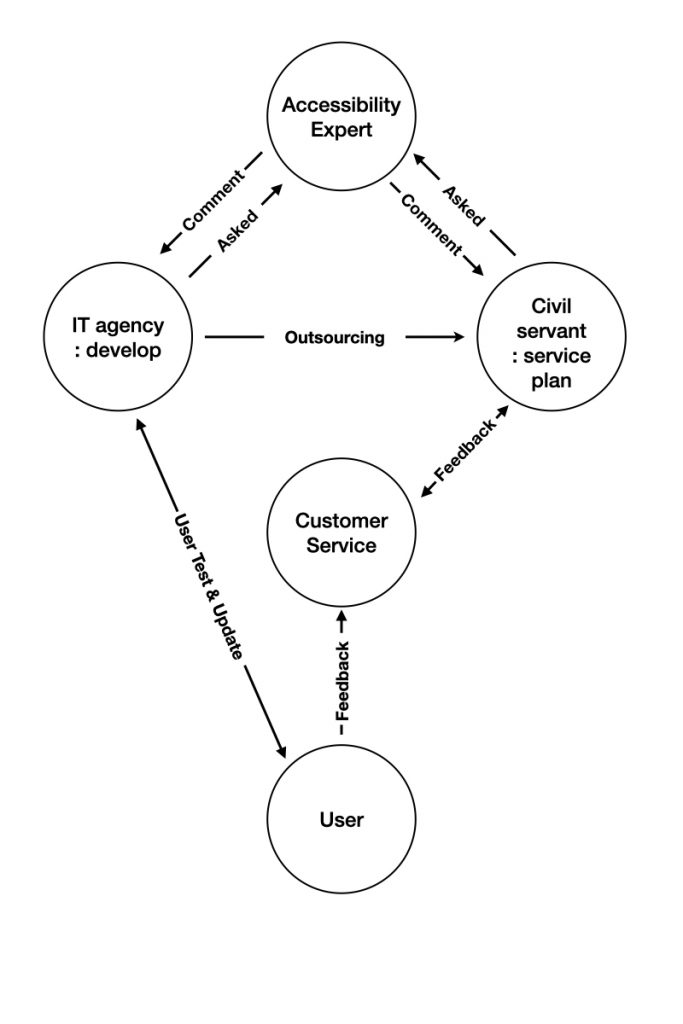
Understanding the digital ecosystem
The project makes two attempts to understand the digital ecosystem.
The first is to find out what e-government has efforts and proposals to improve the accessibility of public app services through literature research. And figure out what limitations and problems it has.
The second is to explore the challenges that visually impaired users face from digital services through field studies, including interviews and observations. I also get opinions and insight from civil servants and experts on why the government efforts are not working.
정부의 디지털 서비스 개발 생태계의 이해
본 연구에서는 정부의 디지털 서비스 개발 생태계를 파악하기 위해 두가지 시도를 합니다.
첫째, 문헌조사를 통해 현 전자정부가 공공 어플리케이션 서비스의 접근성을 향상시키기 위해 어떤 노력과 제안을 하고 있는지 알아보는 것입니다. 그리고 그것이 가지고 있는 한계와 문제점을 파악합니다.
둘째, 인터뷰 및 관찰을 포함한 현장 리서치를 통해 시각 장애인 사용자가 디지털 서비스에서 직면하는 문제를 탐색하는 것입니다. 또한 정부의 접근성 개선의 노력과 제안이 디지털 생태계에서 작동되지 않는 이유에 대해 관련 공직자와 전문가로부터 의견과 통찰력을 얻습니다.
This user experience record manual helps understand and adequately record the complaints of visually impaired users who have difficulties in using public mobile applications. The ultimate goal is to ensure that customer feedback recorded adequately and shared through the user experience record manual and reflected in the digital service update process. I believe this process will be a starting point for public mobile applications to comply with accessibility.
본 논문에서 제안하는 ‘사용자 경험 기록 매뉴얼’ 은 공공 모바일 어플리케이션 이용에 어려움을 겪는 시각장애인 사용자의 민원을 올바르게 이해하고 적절하게 기록할 수 있도록 돕습니다. 본 메뉴얼의 궁극적인 목표는 사용자의 피드백을 적절하게 기록하고 공유하며, 공공 모바일 어플리케이션 업데이트 과정에 반영하는 것입니다. 사용자의 민원을 올바르게 이해하는 과정이 공공 모바일 애플리케이션이 접근성을 준수하는 출발점이 될 것이라고 생각합니다.
